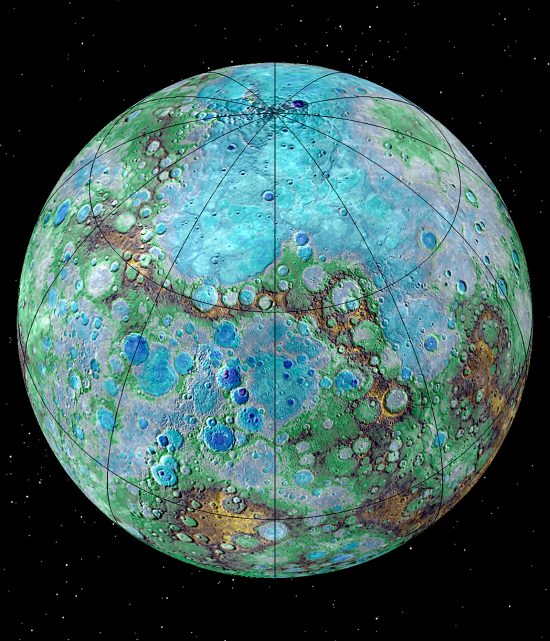
False-color image of Mercury. Credit: NASA/JHUAPL/Carnegie Institution of Washington/USGS/Arizona State University. Click to enlarge.
Jun 15, 2017
Mercury is no longer geologically active.
Mercury has no atmosphere and a weak magnetic field, so it receives the Sun’s radiation with little deflection, similar to Earth’s Moon. Since the Moon is also an airless world, with only traces of a magnetic field, perhaps the Moon and Mercury share similar features because they experienced similar events in the past.
The Moon is 3472 kilometers in diameter and Mercury is 4878 kilometers in diameter. Satellite data confirms that they are almost identical in appearance. No atmosphere and low gravity means no erosion takes place on either body, but the geological formations on both demonstrate similar morphology. The Moon and Mercury are also composed primarily of basalt, the most common mineral in the Solar System.
According to a recent press release, Mercury might be undergoing tectonic changes. Images from the now defunct MESSENGER spacecraft reveal features that appear to indicate Mercury is continuing to cool and contract—meaning it is a tectonically active planet.
Mercury is believed to be almost 75% iron surrounded by a thin shell of silicon-rich rock. Conventional theories have no explanation for its composition. If it formed in a so-called “protoplanetary nebula” like the rest of the Solar System, then so much iron is a mystery because the ratio of iron to silicon is opposite to that of the other rocky planets.
Mercury is thought to have a molten core generating a magnetic field, but no one knows if it is working like Earth’s is supposed to work or if the field is part of the crust, like Mars. No one understands how a molten core exists on Mercury since the planet appears cold and dead. The molten interior should have cooled off eons ago.
As Electric Universe proponent Wal Thornhill wrote:
“In Mercury’s case, its strong gravitational field for its size indicates a high level of internal electrical polarization. That means a high surface charge. So Mercury’s slowly rotating charge will produce a small magnetic field. Other effects will modify that field. For example, currents flow in the plasma above the surface and are induced in the surface of the planet. And there is remanent magnetism associated with old cosmic thunderbolt surface scars.”
Why does the discovery of “small thrust fault scarps” on Mercury point to tectonic activity? Planetary Science Institute Research Scientist Maria Banks wrote:
“These small-scale thrust fault scarps are orders of magnitude smaller, only a few kilometers in length and tens of meters of relief, than larger scarps previously known to exist on the surface of Mercury. Steady meteoroid bombardment quickly degrades and destroys structures this small, indicating that they must have formed relatively recently. They are comparable in size to very young fault scarps identified on the lunar surface attributed to shrinking of the Moon.”
In an Electric Universe, as rocky bodies, like Mercury or the Moon, are ejected from larger, highly charged objects, they are bombarded with what can only be described as gigantic lightning discharges. The electric field between a new planet or moon and its parent are not in equilibrium, so arcing takes place as they rapidly move away from each other. That is why so many celestial objects in the Solar System are seriously damaged. Craters, canyons, melted plains, scattered fields of scorched debris, and ionically deposited piles of dust tell the story of violent birth spasms.
During other catastrophic incidents in the recent past, Mercury was most likely further decimated by electric arcs between it and other charged bodies. The “new” formations on its surface do not mean a geologically active planet, they mean one that has been electrically devastated.
Stephen Smith












